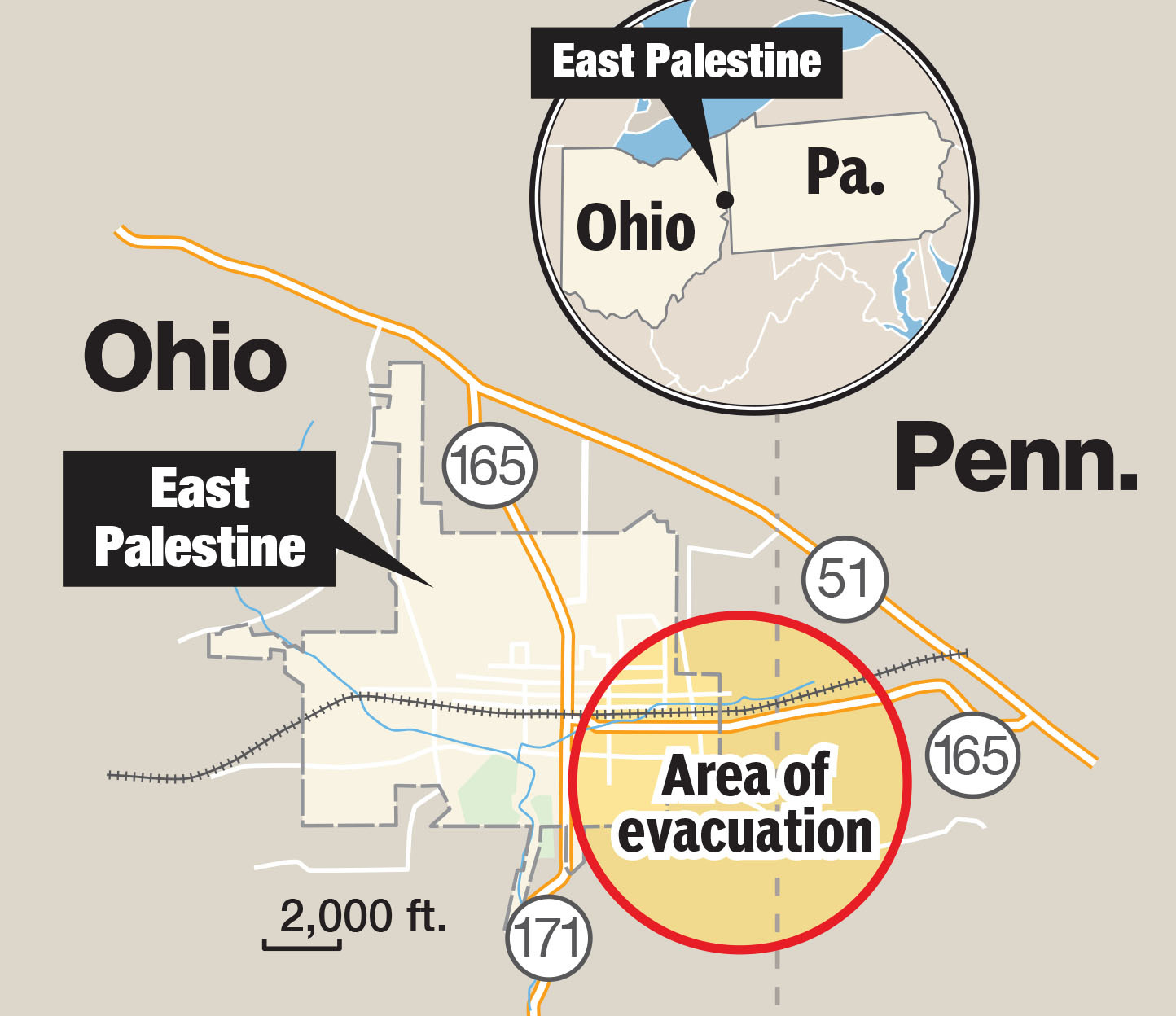Toxic Chemicals From Ohio Train Derailment: Building Contamination And Its Duration

Table of Contents
Types of Toxic Chemicals and Their Impact on Building Materials
The Ohio train derailment released a cocktail of hazardous substances, including vinyl chloride, butyl acrylate, and ethylene glycol monobutyl ether. These chemicals pose significant threats to building materials and the health of occupants.
-
Vinyl Chloride: A known carcinogen, vinyl chloride can seep into various building materials like wood, brick, and concrete. Its volatility allows for rapid indoor air contamination, posing serious respiratory and long-term health risks. Prolonged exposure can lead to liver damage, and an increased risk of several types of cancer.
-
Butyl Acrylate: This highly reactive chemical can react with other substances, potentially creating new and unknown harmful compounds within building materials. It's known to cause skin and eye irritation, and inhalation can lead to respiratory problems. Its penetration into porous materials like wood and drywall is a significant concern.
-
Ethylene Glycol Monobutyl Ether: This chemical can also penetrate various building materials, impacting their structural integrity over time. Exposure can cause skin and eye irritation, headaches, and dizziness. Long-term health effects are still under investigation.
The leaching of these chemicals from contaminated soil and groundwater into building foundations is another serious concern. This process can lead to continuous exposure even after the initial release has subsided. Furthermore, the chemicals can degrade building materials, compromising structural integrity and requiring expensive repairs or replacements. Indoor air quality testing is crucial to assess the level of contamination inside affected buildings.
Assessing the Extent of Building Contamination
Accurately assessing the extent of building contamination following the Ohio train derailment is crucial for effective remediation. This requires a multi-pronged approach utilizing various testing methods.
-
Air Quality Testing: This involves analyzing indoor air samples to identify and quantify the presence of volatile organic compounds (VOCs) like vinyl chloride and butyl acrylate. High concentrations of these chemicals indicate a significant contamination risk.
-
Soil Sampling: Analyzing soil samples from around affected buildings helps determine the extent of soil contamination and the potential for leaching into building foundations. This is vital in assessing the long-term impact on building integrity.
-
Water Testing: Testing well water and other water sources near affected buildings is essential to identify chemical contamination. This helps assess the risk of contamination through groundwater infiltration.
The challenges involved in accurate assessment are multifaceted. The complex chemical interactions within building materials and the varying porosity of different materials can complicate the testing process. The uneven distribution of contaminants further adds to the complexity. Professional environmental consultants with specialized expertise are essential for conducting thorough building inspections, sampling, and interpretation of results to provide accurate assessments. Long-term monitoring is vital to track changes in contamination levels over time.
The Duration of Building Contamination and Remediation
The duration of building contamination following the Ohio train derailment and the subsequent remediation process will depend on several factors.
-
Chemical Properties: The persistence of chemicals in the environment varies widely. Some chemicals break down quickly, while others persist for years. The chemical properties of vinyl chloride, butyl acrylate, and ethylene glycol monobutyl ether determine their longevity in building materials.
-
Building Materials: Porous materials like wood absorb and retain contaminants more readily than non-porous materials like concrete. The type of building materials will influence the speed and extent of contamination.
-
Environmental Conditions: Factors such as temperature, humidity, and rainfall affect the rate of chemical degradation and migration.
Remediation efforts are complex and challenging, potentially requiring extensive cleanup and replacement of contaminated materials. The process can be lengthy, expensive, and disruptive to residents. The potential long-term health risks associated with prolonged exposure to contaminated buildings necessitate a thorough and comprehensive remediation plan. This plan must involve meticulous removal of contaminated materials, proper disposal, and thorough cleaning of affected areas. The cost of remediation, including material replacement, professional services, and long-term monitoring, will be substantial.
Long-Term Health Effects of Exposure to Contaminated Buildings
Exposure to the toxic chemicals released in the Ohio train derailment poses significant long-term health risks.
-
Vinyl Chloride: As previously mentioned, vinyl chloride is a known carcinogen, increasing the risk of liver cancer, brain cancer, and lung cancer.
-
Other Chemicals: The long-term effects of exposure to butyl acrylate and ethylene glycol monobutyl ether are still being studied, but potential impacts include respiratory problems, neurological effects, and various other health issues.
Early detection and intervention are crucial to mitigate potential health problems. Comprehensive health monitoring of affected residents, including regular blood tests and screenings, is necessary. Open communication and access to healthcare resources are vital for the well-being of the community.
Conclusion
The Ohio train derailment has raised serious concerns about the long-term impact of toxic chemical exposure on buildings and the health of the surrounding community. Assessing the extent of contamination from the Ohio train derailment and implementing effective remediation strategies are crucial for mitigating long-term risks. Ongoing monitoring, transparent communication with affected residents, and proactive healthcare support are vital for protecting public health and the environment. Understanding the potential for long-term building contamination is paramount. If you have concerns about your building’s exposure to toxic chemicals from the Ohio train derailment, seek professional assessment and remediation services immediately. Contact your local environmental agency or relevant authorities for assistance and information. Don't hesitate to take proactive steps to protect yourself and your family from the lingering effects of this environmental disaster.

Featured Posts
-
 Mondays D Wave Quantum Qbts Stock Dip A Comprehensive Look
May 20, 2025
Mondays D Wave Quantum Qbts Stock Dip A Comprehensive Look
May 20, 2025 -
 Aghatha Krysty Tewd Ila Alhyat Bfdl Aldhkae Alastnaey
May 20, 2025
Aghatha Krysty Tewd Ila Alhyat Bfdl Aldhkae Alastnaey
May 20, 2025 -
 Preparing Your Home And Garden For Drier Weather
May 20, 2025
Preparing Your Home And Garden For Drier Weather
May 20, 2025 -
 Man Utd News Cunha Signing Imminent Backup Plan Revealed
May 20, 2025
Man Utd News Cunha Signing Imminent Backup Plan Revealed
May 20, 2025 -
 Big Bear Ai Bbai Analyzing The Significant Stock Decline And Its Implications
May 20, 2025
Big Bear Ai Bbai Analyzing The Significant Stock Decline And Its Implications
May 20, 2025
Latest Posts
-
 Saskatchewan Political Scene Impact Of Controversial Federal Remarks
May 21, 2025
Saskatchewan Political Scene Impact Of Controversial Federal Remarks
May 21, 2025 -
 Federal Leaders Saskatchewan Visit Analysis Of Controversial Remarks
May 21, 2025
Federal Leaders Saskatchewan Visit Analysis Of Controversial Remarks
May 21, 2025 -
 Financial Times Bps Ceo Plans For Significant Valuation Increase No Us Market Shift
May 21, 2025
Financial Times Bps Ceo Plans For Significant Valuation Increase No Us Market Shift
May 21, 2025 -
 Saskatchewan Political Panel Federal Leaders Visit Sparks Controversy
May 21, 2025
Saskatchewan Political Panel Federal Leaders Visit Sparks Controversy
May 21, 2025 -
 Bp Ceo Targets Valuation Doubling Remains Committed To Current Stock Exchange Listing
May 21, 2025
Bp Ceo Targets Valuation Doubling Remains Committed To Current Stock Exchange Listing
May 21, 2025
